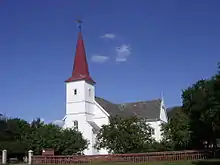Nesna Municipality
Nesna kommune | |
|---|---|
| Nesne herred (historic name) | |
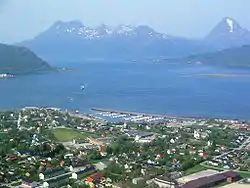 | |
 Flag | |
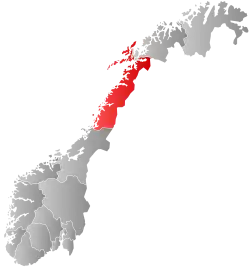 Nordland within Norway | |
 Nesna within Nordland | |
| Coordinates: 66°15′28″N 13°02′06″E / 66.25778°N 13.03500°E | |
| Country | Norway |
| County | Nordland |
| District | Helgeland |
| Established | 1 January 1838 |
| Administrative centre | Nesna |
| Government | |
| • Mayor (2015) | Hanne Davidsen (Ap) |
| Area | |
| • Total | 183.19 km2 (70.73 sq mi) |
| • Land | 181.30 km2 (70.00 sq mi) |
| • Water | 1.89 km2 (0.73 sq mi) 1% |
| • Rank | #309 in Norway |
| Population (2023) | |
| • Total | 1,783 |
| • Rank | #293 in Norway |
| • Density | 9.8/km2 (25/sq mi) |
| • Change (10 years) | |
| Demonym | Nesnaværing[1] |
| Official language | |
| • Norwegian form | Bokmål |
| Time zone | UTC+01:00 (CET) |
| • Summer (DST) | UTC+02:00 (CEST) |
| ISO 3166 code | NO-1828[3] |
| Website | Official website |
Nesna is a municipality in Nordland county, Norway. It is part of the Helgeland traditional region. The administrative centre of the municipality is the village of Nesna. Other villages in Nesna include Handnesneset, Husby, Saura, and Vikholmen.
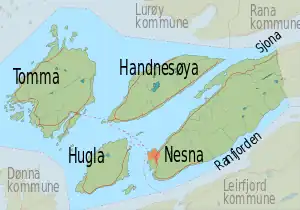
The municipality consists of the three islands Tomma, Hugla (known as "Hugløy" by its inhabitants), and Handnesøya, and one peninsula that bears the name of the municipality, Nesna. The old Husby Estate is headquartered in Husby on Tomma island.
The Coastal Express arrives two times a day at the village of Nesna, the northbound arrives 05:30 and the southbound 11:15. The village of Nesna is also home to Nordland's education center Nesna University College, and there is also the KVN High School, and Nesna Church.
The 183-square-kilometre (71 sq mi) municipality is the 309th largest by area out of the 356 municipalities in Norway. Nesna is the 293rd most populous municipality in Norway with a population of 1,783. The municipality's population density is 9.8 inhabitants per square kilometre (25/sq mi) and its population has decreased by 4.9% over the previous 10-year period.[4][5]
General information
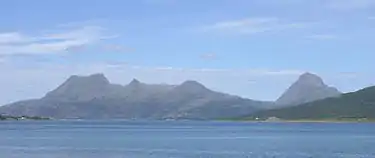
Nesna was established as a municipality on 1 January 1838 (see formannskapsdistrikt law). The western island district of Nesna (population: 1,348) was separated from Nesna on 1 July 1888 to form the new municipality of Dønnes. This left Nesna with 2,958 residents. On 1 January 1919, the Bardalssjøen farm (population: 4) was transferred from Hemnes Municipality to Nesna Municipality. In 1945, a small area of southern Nesna (population: 26) was transferred to Leirfjord Municipality.
During the 1960s, there were many municipal mergers across Norway due to the work of the Schei Committee. On 1 January 1962, part of the island of Løkta (population: 80) was transferred from Nesna to the new Dønna Municipality and part of the island of Tomma (population: 80) was transferred from the old municipality of Dønnes to Nesna Municipality. Then on 1 January 1964, the Bardalssjøen area of Nesna, located south of the Ranfjorden, was transferred to Leirfjord Municipality. On that same date, the part of Nesna around the inner part of the Sjona fjord was transferred to Rana Municipality.[6]
Name
The municipality (originally the parish) is named after the old Nesna farm (Old Norse: Nesnar) since the first Nesna Church was built there. The name is derived from the word nes which means "headland".[7] Historically, the name of the municiaplity was spelled Nesne. On 6 January 1908, a royal resolution changed the spelling of the name of the municipality to Nesna.[8]
Coat of arms
The coat of arms was granted on 23 June 1989. The official blazon is "Per chevron inverted Or and Azure" (Norwegian: Delt av gull og blått ved omvendt sparresnitt). This means the arms have a field (background) that is divided by a line in the form of an inverted chevron pattern. The background above the line has a tincture of Or which means it is commonly colored yellow, but if it is made out of metal, then gold is used. The background below the line has a tincture of azure. The arms are a canting of the name of the municipality (Nesna comes form nes which means headland in Norwegian). The arms show a yellow-colored "headland" or peninsula surrounded by blue water. The arms were designed by Jarle E. Henriksen.[9][10][11][12]
Churches
The Church of Norway has one parish (sokn) within the municipality of Nesna. It is part of the Nord-Helgeland prosti (deanery) in the Diocese of Sør-Hålogaland.
| Parish (sokn) | Church name | Location of the church | Year built |
|---|---|---|---|
| Nesna | Nesna Church | Nesna | 1880 |
| Handnesøya Chapel | Saura | 1969 | |
| Husby Chapel | Husby | 1905 |
Government
All municipalities in Norway are responsible for primary education (through 10th grade), outpatient health services, senior citizen services, welfare and other social services, zoning, economic development, and municipal roads and utilities. The municipality is governed by a municipal council of directly elected representatives. The mayor is indirectly elected by a vote of the municipal council.[13] The municipality is under the jurisdiction of the Helgeland District Court and the Hålogaland Court of Appeal.
Municipal council
The municipal council (Kommunestyre) of Nesna is made up of 17 representatives that are elected to four-year terms. The tables below show the current and historical composition of the council by political party.
| Party name (in Norwegian) | Number of representatives | |
|---|---|---|
| Labour Party (Arbeiderpartiet) | 7 | |
| Progress Party (Fremskrittspartiet) | 1 | |
| Centre Party (Senterpartiet) | 3 | |
| Socialist Left Party (Sosialistisk Venstreparti) | 3 | |
| Joint List(s) of Non-Socialist Parties (Borgerlige Felleslister) | 3 | |
| Total number of members: | 17 | |
| Party name (in Norwegian) | Number of representatives | |
|---|---|---|
| Labour Party (Arbeiderpartiet) | 7 | |
| Green Party (Miljøpartiet De Grønne) | 1 | |
| Centre Party (Senterpartiet) | 4 | |
| Socialist Left Party (Sosialistisk Venstreparti) | 2 | |
| Joint List(s) of Non-Socialist Parties (Borgerlige Felleslister) | 3 | |
| Total number of members: | 17 | |
| Party name (in Norwegian) | Number of representatives | |
|---|---|---|
| Labour Party (Arbeiderpartiet) | 7 | |
| Green Party (Miljøpartiet De Grønne) | 1 | |
| Conservative Party (Høyre) | 3 | |
| Centre Party (Senterpartiet) | 3 | |
| Socialist Left Party (Sosialistisk Venstreparti) | 3 | |
| Total number of members: | 17 | |
| Party name (in Norwegian) | Number of representatives | |
|---|---|---|
| Labour Party (Arbeiderpartiet) | 4 | |
| Progress Party (Fremskrittspartiet) | 2 | |
| Conservative Party (Høyre) | 5 | |
| Centre Party (Senterpartiet) | 3 | |
| Socialist Left Party (Sosialistisk Venstreparti) | 2 | |
| Liberal Party (Venstre) | 1 | |
| Total number of members: | 17 | |
| Party name (in Norwegian) | Number of representatives | |
|---|---|---|
| Labour Party (Arbeiderpartiet) | 4 | |
| Progress Party (Fremskrittspartiet) | 3 | |
| Conservative Party (Høyre) | 2 | |
| Centre Party (Senterpartiet) | 3 | |
| Socialist Left Party (Sosialistisk Venstreparti) | 3 | |
| Liberal Party (Venstre) | 2 | |
| Total number of members: | 17 | |
| Party name (in Norwegian) | Number of representatives | |
|---|---|---|
| Labour Party (Arbeiderpartiet) | 4 | |
| Progress Party (Fremskrittspartiet) | 5 | |
| Conservative Party (Høyre) | 2 | |
| Centre Party (Senterpartiet) | 2 | |
| Socialist Left Party (Sosialistisk Venstreparti) | 3 | |
| Liberal Party (Venstre) | 1 | |
| Total number of members: | 17 | |
| Party name (in Norwegian) | Number of representatives | |
|---|---|---|
| Labour Party (Arbeiderpartiet) | 7 | |
| Conservative Party (Høyre) | 3 | |
| Centre Party (Senterpartiet) | 3 | |
| Socialist Left Party (Sosialistisk Venstreparti) | 2 | |
| Liberal Party (Venstre) | 2 | |
| Total number of members: | 17 | |
| Party name (in Norwegian) | Number of representatives | |
|---|---|---|
| Labour Party (Arbeiderpartiet) | 4 | |
| Conservative Party (Høyre) | 2 | |
| Centre Party (Senterpartiet) | 4 | |
| Socialist Left Party (Sosialistisk Venstreparti) | 2 | |
| Liberal Party (Venstre) | 2 | |
| Cooperative list for Nesna (Samarbeidslista for Nesna) | 3 | |
| Total number of members: | 17 | |
| Party name (in Norwegian) | Number of representatives | |
|---|---|---|
| Labour Party (Arbeiderpartiet) | 7 | |
| Conservative Party (Høyre) | 2 | |
| Centre Party (Senterpartiet) | 4 | |
| Socialist Left Party (Sosialistisk Venstreparti) | 3 | |
| Liberal Party (Venstre) | 1 | |
| Total number of members: | 17 | |
| Party name (in Norwegian) | Number of representatives | |
|---|---|---|
| Labour Party (Arbeiderpartiet) | 9 | |
| Conservative Party (Høyre) | 3 | |
| Centre Party (Senterpartiet) | 3 | |
| Socialist Left Party (Sosialistisk Venstreparti) | 1 | |
| Liberal Party (Venstre) | 1 | |
| Total number of members: | 17 | |
| Party name (in Norwegian) | Number of representatives | |
|---|---|---|
| Labour Party (Arbeiderpartiet) | 7 | |
| Conservative Party (Høyre) | 5 | |
| Christian Democratic Party (Kristelig Folkeparti) | 1 | |
| Socialist Left Party (Sosialistisk Venstreparti) | 1 | |
| Joint list of the Centre Party (Senterpartiet) and the Liberal Party (Venstre) | 3 | |
| Total number of members: | 17 | |
| Party name (in Norwegian) | Number of representatives | |
|---|---|---|
| Labour Party (Arbeiderpartiet) | 6 | |
| Conservative Party (Høyre) | 4 | |
| Christian Democratic Party (Kristelig Folkeparti) | 1 | |
| Socialist Left Party (Sosialistisk Venstreparti) | 1 | |
| Joint list of the Centre Party (Senterpartiet) and the Liberal Party (Venstre) | 4 | |
| Election list for the Tomma area (Valgliste for Tomma krets) | 1 | |
| Total number of members: | 17 | |
| Party name (in Norwegian) | Number of representatives | |
|---|---|---|
| Labour Party (Arbeiderpartiet) | 6 | |
| Christian Democratic Party (Kristelig Folkeparti) | 1 | |
| Centre Party (Senterpartiet) | 2 | |
| Socialist Left Party (Sosialistisk Venstreparti) | 1 | |
| Joint list of independent voters, the Conservative Party, and the Liberal Party (Samarbeidsliste av Uavhengige Velgere, Høyre og Venstre) |
5 | |
| Election list for the Tomma area (Valgliste for Tomma krets) | 2 | |
| Total number of members: | 17 | |
| Party name (in Norwegian) | Number of representatives | |
|---|---|---|
| Labour Party (Arbeiderpartiet) | 7 | |
| Christian Democratic Party (Kristelig Folkeparti) | 1 | |
| Centre Party (Senterpartiet) | 2 | |
| Liberal Party (Venstre) | 1 | |
| Local List(s) (Lokale lister) | 6 | |
| Total number of members: | 17 | |
| Party name (in Norwegian) | Number of representatives | |
|---|---|---|
| Labour Party (Arbeiderpartiet) | 9 | |
| Conservative Party (Høyre) | 1 | |
| Christian Democratic Party (Kristelig Folkeparti) | 1 | |
| Centre Party (Senterpartiet) | 3 | |
| Liberal Party (Venstre) | 2 | |
| Local List(s) (Lokale lister) | 1 | |
| Total number of members: | 17 | |
| Party name (in Norwegian) | Number of representatives | |
|---|---|---|
| Labour Party (Arbeiderpartiet) | 9 | |
| Conservative Party (Høyre) | 2 | |
| Centre Party (Senterpartiet) | 4 | |
| Liberal Party (Venstre) | 1 | |
| Local List(s) (Lokale lister) | 1 | |
| Total number of members: | 17 | |
| Party name (in Norwegian) | Number of representatives | |
|---|---|---|
| Labour Party (Arbeiderpartiet) | 9 | |
| Conservative Party (Høyre) | 3 | |
| Centre Party (Senterpartiet) | 5 | |
| Liberal Party (Venstre) | 2 | |
| Local List(s) (Lokale lister) | 2 | |
| Total number of members: | 21 | |
| Party name (in Norwegian) | Number of representatives | |
|---|---|---|
| Labour Party (Arbeiderpartiet) | 10 | |
| List of workers, fishermen, and small farmholders (Arbeidere, fiskere, småbrukere liste) | 2 | |
| Joint List(s) of Non-Socialist Parties (Borgerlige Felleslister) | 9 | |
| Total number of members: | 21 | |
| Party name (in Norwegian) | Number of representatives | |
|---|---|---|
| Labour Party (Arbeiderpartiet) | 11 | |
| Joint List(s) of Non-Socialist Parties (Borgerlige Felleslister) | 10 | |
| Total number of members: | 21 | |
| Party name (in Norwegian) | Number of representatives | |
|---|---|---|
| Labour Party (Arbeiderpartiet) | 13 | |
| Joint List(s) of Non-Socialist Parties (Borgerlige Felleslister) | 7 | |
| Local List(s) (Lokale lister) | 1 | |
| Total number of members: | 21 | |
| Party name (in Norwegian) | Number of representatives | |
|---|---|---|
| Labour Party (Arbeiderpartiet) | 14 | |
| Local List(s) (Lokale lister) | 7 | |
| Total number of members: | 21 | |
| Party name (in Norwegian) | Number of representatives | |
|---|---|---|
| Labour Party (Arbeiderpartiet) | 5 | |
| List of workers, fishermen, and small farmholders (Arbeidere, fiskere, småbrukere liste) | 1 | |
| Joint List(s) of Non-Socialist Parties (Borgerlige Felleslister) | 6 | |
| Local List(s) (Lokale lister) | 4 | |
| Total number of members: | 16 | |
| Note: Due to the German occupation of Norway during World War II, no elections were held for new municipal councils until after the war ended in 1945. | ||
Mayors
- 1838–1848: Johan Augustinussen
- 1848–1850: Fredrik Christian Sand
- 1850–1854: Johan Augustinussen
- 1854–1867: Elias Olsen
- 1867–1876: Jacob Fredrik Zahl
- 1877–1880: Elias Olsen
- 1881–1890: Carl Jøsevold
- 1891–1894: Jakob Beck
- 1894–1896: Lorents Pettersen
- 1896–1898: Christian F. Olsen
- 1899–1907: Carl Jøsevold
- 1908–1914: Nils Haugen
- 1915–1918: Anders Pettersen
- 1919–1922: Møller Zahl Hauknes
- 1922–1925: Ivar Hjellvik
- 1926–1928: Laurits Riise
- 1929–1942: Arne Langset (V)
- 1943–1945: Anders Forsland
- 1945-1945: Arne Langset (V)
- 1946–1952: Johan Knutsen (Ap)
- 1952–1956: Einar Enga (Ap)
- 1956–1957: Olaus Berg (H)
- 1958–1964: Edvard Kaspersen (Ap)
- 1964-1964: Henry Antonsen (Ap)
- 1964–1965: Håkon Langseth (Sp)
- 1966–1967: Leander Paulsen (Ap)
- 1968–1971: Arne Herseth (Ap)
- 1972–1973: Edvard Kaspersen (LL)
- 1974–1975: Arne Herseth (Ap)
- 1976–1981: Mathias Sellæg Moe (V)
- 1982–1983: Kåre Eriksen (H)
- 1984–1985: Ole A. Selseth (V)
- 1986–1987: Arne Herseth (Ap)
- 1988–1991: Øyvind Jenssen (Ap)
- 1991–1995: Anne-Lise Wold (Ap)
- 1996–1999: Gunnhild Forsland (Sp)
- 1999–2007: Anne-Lise Wold (Ap)
- 2007-2011: Ronny Sommerro (Ap)
- 2011-2015: Marit Bye (H)
- 2015–present: Hanne Davidsen (Ap)
Notable residents
- Johan Augustinussen (born 1808 at Langset - 1888 in Nesna), a curate/choirmaster, teacher, and politician
- Hans Christiansen (1867 in Nesna – 1938), a sailor who competed at the 1912 Summer Olympics
- Birger Fredrik Motzfeldt OBE, CVO (1898 in Nesna – 1987), a Norwegian aviator and senior military officer.
- Ida Maria (born 1984), a Norwegian musician and singer-songwriter; born and lives in Nesna
- Emil Weber Meek (born 1988), a Norwegian professional mixed martial artist, brought up in Nesna
- Ulrik Berglann (born 1992 in Nesna), a Norwegian footballer with 180 club caps
References
- ↑ "Navn på steder og personer: Innbyggjarnamn" (in Norwegian). Språkrådet.
- ↑ "Forskrift om målvedtak i kommunar og fylkeskommunar" (in Norwegian). Lovdata.no.
- ↑ Bolstad, Erik; Thorsnæs, Geir, eds. (26 January 2023). "Kommunenummer". Store norske leksikon (in Norwegian). Kunnskapsforlaget.
- ↑ Statistisk sentralbyrå. "Table: 06913: Population 1 January and population changes during the calendar year (M)" (in Norwegian).
- ↑ Statistisk sentralbyrå. "09280: Area of land and fresh water (km²) (M)" (in Norwegian).
- ↑ Jukvam, Dag (1999). "Historisk oversikt over endringer i kommune- og fylkesinndelingen" (PDF) (in Norwegian). Statistisk sentralbyrå.
- ↑ Rygh, Oluf (1905). Norske gaardnavne: Nordlands amt (in Norwegian) (16 ed.). Kristiania, Norge: W. C. Fabritius & sønners bogtrikkeri. p. 119.
- ↑ "Norsk Lovtidende. 2den Afdeling. 1908. Samling af Love, Resolutioner m.m". Norsk Lovtidend (in Norwegian). Kristiania, Norge: Grøndahl og Søns Boktrykkeri: 24. 1908.
- ↑ "Civic heraldry of Norway - Norske Kommunevåpen". Heraldry of the World. Retrieved 4 February 2023.
- ↑ "Nesna, Nordland (Norway)". Flags of the World. Retrieved 4 February 2023.
- ↑ "Godkjenning av våpen og flagg". Lovdata.no (in Norwegian). Norges kommunal- og arbeidsdepartementet. 9 September 1989. Retrieved 4 February 2023.
- ↑ Store norske leksikon. "Nesna – Kommune i Nordland" (in Norwegian). Retrieved 24 January 2012.
- ↑ Hansen, Tore; Vabo, Signy Irene, eds. (20 September 2022). "kommunestyre". Store norske leksikon (in Norwegian). Kunnskapsforlaget. Retrieved 14 October 2022.
- ↑ "Kommunestyrevalg 2023 - Nordland". Valg Direktoratet. Retrieved 27 December 2023.
- ↑ "Tall for Norge: Kommunestyrevalg 2019 - Nordland". Valg Direktoratet. Retrieved 27 October 2019.
- 1 2 3 4 "Table: 04813: Members of the local councils, by party/electoral list at the Municipal Council election (M)" (in Norwegian). Statistics Norway.
- ↑ "Tall for Norge: Kommunestyrevalg 2011 - Nordland". Valg Direktoratet. Retrieved 27 October 2019.
- ↑ "Kommunestyrevalget 1995" (PDF) (in Norwegian). Oslo-Kongsvinger: Statistisk sentralbyrå. 1996. Retrieved 2 April 2020.
- ↑ "Kommunestyrevalget 1991" (PDF) (in Norwegian). Oslo-Kongsvinger: Statistisk sentralbyrå. 1993. Retrieved 2 April 2020.
- ↑ "Kommunestyrevalget 1987" (PDF) (in Norwegian). Oslo-Kongsvinger: Statistisk sentralbyrå. 1988. Retrieved 2 April 2020.
- ↑ "Kommunestyrevalget 1983" (PDF) (in Norwegian). Oslo-Kongsvinger: Statistisk sentralbyrå. 1984. Retrieved 2 April 2020.
- ↑ "Kommunestyrevalget 1979" (PDF) (in Norwegian). Oslo: Statistisk sentralbyrå. 1979. Retrieved 2 April 2020.
- ↑ "Kommunevalgene 1975" (PDF) (in Norwegian). Oslo: Statistisk sentralbyrå. 1977. Retrieved 2 April 2020.
- ↑ "Kommunevalgene 1972" (PDF) (in Norwegian). Oslo: Statistisk sentralbyrå. 1973. Retrieved 2 April 2020.
- ↑ "Kommunevalgene 1967" (PDF) (in Norwegian). Oslo: Statistisk sentralbyrå. 1967. Retrieved 2 April 2020.
- ↑ "Kommunevalgene 1963" (PDF) (in Norwegian). Oslo: Statistisk sentralbyrå. 1964. Retrieved 2 April 2020.
- ↑ "Kommunevalgene og Ordførervalgene 1959" (PDF) (in Norwegian). Oslo: Statistisk sentralbyrå. 1960. Retrieved 2 April 2020.
- ↑ "Kommunevalgene og Ordførervalgene 1955" (PDF) (in Norwegian). Oslo: Statistisk sentralbyrå. 1957. Retrieved 2 April 2020.
- ↑ "Kommunevalgene og Ordførervalgene 1951" (PDF) (in Norwegian). Oslo: Statistisk sentralbyrå. 1952. Retrieved 2 April 2020.
- ↑ "Kommunevalgene og Ordførervalgene 1947" (PDF) (in Norwegian). Oslo: Statistisk sentralbyrå. 1948. Retrieved 2 April 2020.
- ↑ "Kommunevalgene og Ordførervalgene 1945" (PDF) (in Norwegian). Oslo: Statistisk sentralbyrå. 1947. Retrieved 2 April 2020.
- ↑ "Kommunevalgene og Ordførervalgene 1937" (PDF) (in Norwegian). Oslo: Statistisk sentralbyrå. 1938. Retrieved 2 April 2020.
- ↑ Jensen, Øyvind (1998). Nesna 1800−1920. Fra prestegjeld til kommune, Bygdebok for Nesna (in Norwegian). Vol. 2. Mosjøen, Nesna kommune: Rønnes Trykk AS. ISBN 8299403812.
External links
- Municipal fact sheet from Statistics Norway (in Norwegian)
 Nordland travel guide from Wikivoyage
Nordland travel guide from Wikivoyage- Official site of Nesna Municipality
- Hammerø nature reserve
- Dillern-Ørnes nature reserve at Handnesøya
- Husbymarka nature reserve at Tomma

